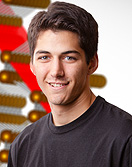News
Research opportunities push
undergraduate education boundaries
Phil Tucciarone knew as a high school student that he wanted to study nanotechnology; it was just a matter of where.
The Ivy League was an option, but so was UB, where he enrolled in 2010. The decision paid off. Already a published scientist, the rising junior and University Honors College student is managing a university-funded research project that focuses on—you guessed it—nanotechnology.
“UB is like an open slate,” says Tucciarone, a chemical engineering major from Washingtonville, N.Y. “Everyone has the opportunity to do great work.”
Whether assisting an English professor who is writing about gender issues or performing research at medical device manufacturer Greatbatch Inc., UB students are pushing the boundaries of a traditional undergraduate education. While the classroom remains the foundation of UB’s educational experience, thousands of undergraduates are working with faculty members or in the community to better prepare themselves for the workplace.
It wasn’t always this way.
Like many institutions of higher learning, research at UB typically was limited to graduate students. That began to change during the past decade when university leaders, after deciding that undergraduates needed more opportunities outside the classroom, formed the Center for Undergraduate Research and Creative Activities, or CURCA.
Led by Tim Tryjankowski, CURCA spends $50,000 each year on undergraduate research. The money is spread throughout UB’s more than 100 undergraduate programs. Students can receive up to $1,500 each year.
“Students utilizing CURCA are gaining hands-on experience that will help them stand out as they apply for jobs, go to graduate school or seek additional research grants,” Tryjankowski says.
He highlighted CURCA’s grant application process, which mimics the National Science Foundation, one of the nation’s primary funding sources of academic research. Learning how to write a competitive grant application is a unique and valuable aspect of CURCA, Tryjankowski says.
Undergraduate research isn’t limited to CURCA. Some students, such as Mariel Schneggenburger, work through UB’s Honors College. The rising junior is doing mathematical research this summer at the University of Wisconsin-Madison.
Other students, such as Kari Puma, secured internships with the assistance of their professors. A rising senior and biomedical engineering major, Puma helps researchers at Akron-based Greatbatch develop tools that could aid people suffering from bone and joint problems.
“It’s really great,” she says of the paid internship, “because I’m really interested in orthopaedics and sports medicine.”
She is working with Mark Ehrensberger, assistant professor of biomedical engineering and director of the university’s Orthopaedic Research Laboratory.
Tucciarone, the chemical engineering major, is working with Mark Swihart, professor of chemical and biological engineering, and Folarin Erogbogbo, postdoctoral scholar and research assistant professor of chemistry. He is exploring silicon nanoparticles’ ability to create hydrogen as an alternative energy source. This involves using powerful lasers inside Furnas Hall on UB’s North Campus.
He previously co-wrote a paper with the more experienced researchers.
“I guess I’m pretty lucky,” Tucciarone says.


Reader Comments